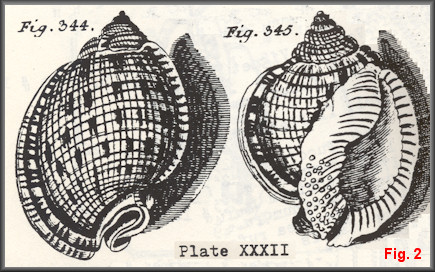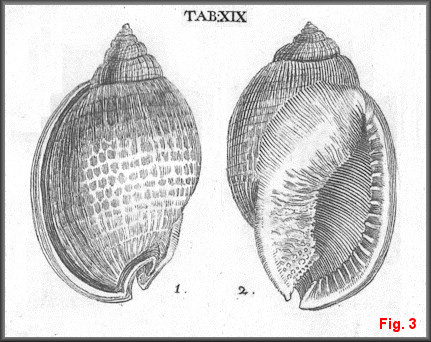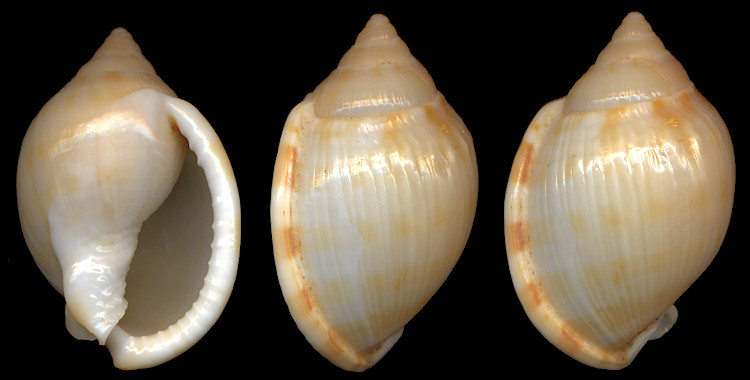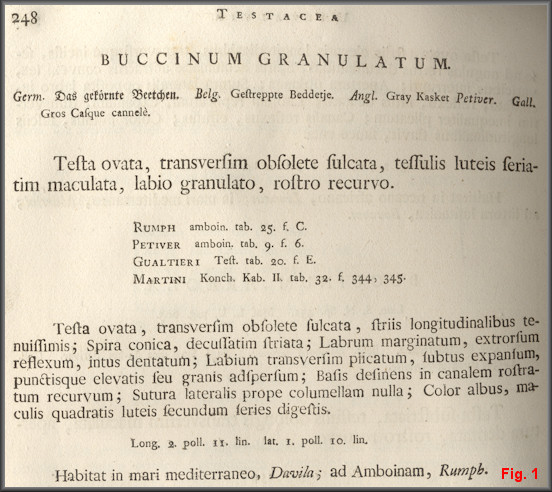|
Semicassis granulata granulata (Born, 1778) form cicatricosa (Gmelin, 1791) |
|
|
|
|
|
Under coral in 85 feet of water, West Palm Beach, FL (28.5 mm.) |
|
|
Is Semicassis cicatricosa (Gmelin, 1791) [Tonnoidea: Tonnidae: Cassinae] a valid biotaxon? |
|
|
Elucidating the status of this western Atlantic bonnet shell is like
peeling an onion. There are layers upon layers of complexities, and,
as each one is removed, it can serve as a tender morsel of the
process of taxonomy or nomenclature which the mind can savor. Its placement at the family-level might be considered the onion's outer husk. As indicated in the above title, the current assignment is superfamily Tonnoidea, family Tonnidae, subfamily Cassinae. This hierarchy has appeared in a variety of iterations and spellings over the years and may well seem a bit strange to veteran collectors and curators. Yet it is the reasoned result of a succession of nomenclatorial events. Tonnidae (as Doliidae) and Cassidae both date from Latreille (1825: 196, 194 respectively) so neither has immediate claim to priority. First, let's deal with Doliidae: Suter (1913) placed Dolium Lamarck, 1801 in synonymy with Tonna Brünnich, 1772, and, although he made no reference to any relevant family-level taxon, as a consequence of his action both Tonna and Tonnidae were in prevailing usage through the Twentieth Century and beyond. On that basis, Bouchet and Rocroi (2005: 172) invoked the provisions of Article 40.2 of the International Code of Zoological Nomenclature (ICZN, 1999) for the conservation of Tonnidae and suppression of the synonymous Doliidae. Earlier, Wenz (1941: 1045), acting as first reviser, had declared "Tonnacea," later converted to "Tonnoidea," in compliance with Article 29.2 of the Code ICZN, 1999, and thus Tonnidae, superordinate to Cassidae. We now have the basis for "Tonnoidea: Tonnidae" in the title. Confusing? Yes, but by the rules. Just under onion's the flaky husk is another tough layer: The author's clear intentions notwithstanding, Latreille's "Cassidae" was not the proper formation of a family name based on the genus Cassis Scopoli, 1777. Article 29.3.1 of the Code (ICZN, 1999) mandates that the stem of the type genus "is found by deleting the case ending of the appropriate genitive singular," in this instance leading to "Cassid-" via "Cassidis." So why not simply emend Cassidae to Cassididae? This remedy, while reasoned, runs afoul of that old troublemaker, homonymy. It happens that Linnaeus (1758: 362) named a genus of beetles Cassida, and Gyllenhal (1813: 434) based a family-level name, Cassidites, later emended to Cassidinae, on the Linnaean genus. Thus Cassididae Latreille, 1825, or any other family-level name based on the same stem by any author after 1813, is unavailable for the purposes of taxonomic nomenclature under the provisions of the Principle of Homonymy (ICZN, 1999: 53.1, 55.5). Since Cassidae Latreille, 1825 was in widespread use and not a homonym, the ICZN was petitioned to forgive its fraudulent etymology and conserve it by exercise of its plenary powers. This exception was granted (Melville, 1974), and the family-level taxon, Cassoidea, Cassidae, Cassinae, is now available. But, as noted above, it is subordinate to Tonnoidea, Tonnidae, Tonninae when the former is considered synonymous at the same taxonomic rank. Thus we have arrived at "Cassinae" in the title. The bulb is now stripped of its outermost layers, and we may begin to delve into the more comestible parts: The genus Semicassis Mørch, 1852 is based on Cassis japonica Reeve, 1848 by the subsequent designation [SD] of Harris, 1897. Abbott (1968: 125, 128) considered Phalium bisulcatum Schubert and Wagner, 1829 to be a senior synonym of the Reeve name. Although it was treated as a subgenus of Phalium Link, 1807 [Type Species (TS): Buccinum glaucum Linnaeus, 1758 SD Dall, 1909] by Abbott (1968: 125), modern authors, e.g., Malacolog 4.1.1, Kreipl, 1997, have afforded this circumtropical group full generic rank. Tylocassis Woodring, 1928 [TS Buccinum inflatum Shaw, 1811 (= B. granulatum Born, 1778 fide Abbott, 1968) by original designation (OD)] is treated as a synonym, not a subgenus, of Semicassis by Kreipl (1997: 48). Thus we have reached the taxon Semicassis granulata (Born, 1778) and the innermost layers of this pungent, tantalizing herb. |
|
|
|
|
The Austrian conchologist Ignatius von Born (1742-1791) laid
a straightforward foundation for the nominal species Buccinum
granulatum, widely-known as the Scotch Bonnet. It was described
(Born, 1778: 239-240; repeated in Born, 1780: 248:
Fig. 1) rather precisely and four
illustrations were cited. Of these, the type was restricted to
Martini (1773: plate 32, figs. 344, 345; Fig. 2) by Clench (1944: 6;
citing Born, 1780 vice 1778). Since Born had placed the
species in the Mediterranean and
 Amboina, Clench (Idem)
designated Puerto Plata, Dominican Republic as the type locality.
While it is generally accepted that there are two allopatric
subspecies beside the nominotypical Born taxon, the taxonomic status
of a smooth western Atlantic morph, which we may call Semicassis
cicatricosa (Gmelin, 1791) for the purposes of argument, is
controversial. Although the majority of authors seem to regard this
as a mere morph of the Scotch Bonnet, others, e.g. Gibson-Smith and
Gibson-Smith (1981) De Jong and Coomans (1988: 67), and Rosenberg
(2009), treat it as a separate taxon at the species level. In
support of the three preceding authorities, I shall proceed in
satanic advocacy, attempt a proper analysis of S. cicatricosa
(Gmelin, 1791), and strip the onion to its core. Amboina, Clench (Idem)
designated Puerto Plata, Dominican Republic as the type locality.
While it is generally accepted that there are two allopatric
subspecies beside the nominotypical Born taxon, the taxonomic status
of a smooth western Atlantic morph, which we may call Semicassis
cicatricosa (Gmelin, 1791) for the purposes of argument, is
controversial. Although the majority of authors seem to regard this
as a mere morph of the Scotch Bonnet, others, e.g. Gibson-Smith and
Gibson-Smith (1981) De Jong and Coomans (1988: 67), and Rosenberg
(2009), treat it as a separate taxon at the species level. In
support of the three preceding authorities, I shall proceed in
satanic advocacy, attempt a proper analysis of S. cicatricosa
(Gmelin, 1791), and strip the onion to its core.The first notice of the topical shell was contemporary with Born's description of S. granulatum. Frederich Christian Meuschen (1719-1811) is a fairly obscure figure in the history of conchology, but to say his work, the Museum Gronovianum .... is simply rare and obscure does disservice to what may be the most recondite of all published  conchological
works. It is not mentioned in Dillwyn (1817) or Dance (1986) and is
not among the 60,000 items listed in the British Museum's library
(Woodward et. al., 1903-1940). Nonetheless the book has been
digitized, is now in the public domain, and provides the passage:
"1158 [Buccinum] cicatricosum Pokdaalige Huid. Gr. Z. III n. 1350 &
Tab. II. fig. 1. 2, L. sp. o. Een stuk." (Meuschen, 1778: 115).
Since the only indication, the cited illustration, was not published
until about two years later (Gronovius, 1781a, b), this is a
nomen nudum and thus, by this fact alone, unavailable for the
purposes of taxonomic nomenclature (ICZN, 1999: Articles 12.1,
12.2). The Gronovius figures [our Fig. 3]
can be found at the top of "TAB XIX," which plate is also labelled
"Fasc. III Tab. II" at its bottom teste R.I. Johnson (pers.
comm. 27 November, 2010). Authors, e.g., Meuschen (1778:
115), Gmelin (1791: 1475), Dillwyn (1817: 597), and Clench (1944:
8), agree on the figure citation while variously locating the
companion text, i.e., "no. 1350," "p. 303," or "v." When
considered along with the binomen again provided by Meuschen (1781a,
b), Buccinum cicatricosum Meuschen in Gronovius,
1781a, b appears to be an available name for our straw man. However,
after initial acceptance (ICZN, 1910: Opinion 20, 48-50) of the most
important work of this second obscure Dutch naturalist, Laurens
Theodore Gronow (1730-1777 or 1778), his Zoophylacii .... (Gronovius,
1763, 1764, and 1781a, b),* were subsequently declared unavailable
for the purposes of taxonomic nomenclature (ICZN, 1925: Opinion 89,
27-33; 1950; 1954b; 1958). Quite familiar with the 1781 Gronovius
work (since he was its editor and wrote its index), Meuschen (1787:
392; species no. 1290) later reported: "C[asque] Cicatricosa,
ventricosa, anfractibus nodosis, testa maculis quadritis impressus,
Linn. [1767] 453. [alpha]. s. o. Gronov. Zooph. III. 19. 1.
2. Petiv. Mus, 7. 4. (4. specim. 772*" in his catalogue of
the shell collection of yet another Dutchman, Abraham Pauluszoon
Gevers (1712-1780). Déjà vu, this appears to be a validly proposed
binomen with a description and unambiguous figure citation, and it
was treated as an available name by some authors, e.g., Dall
(1923) and Clench (1944: 8). Nonetheless, all of Meuschen's works
have been officially declared, or otherwise treated as, unavailable
because of inconsistent application of binominal nomenclature (ICZN,
1954a, 1958, 1999: Article 11.4; Winckworth, 1926). Recourse to the
Gronovius and Meuschen works having been denied, one must credit
Gmelin (1791: 3475-6) as the first to validate the binomen
Buccinum cicatricosum. Although he cited India as the "habitat,"
the consensus synonym, B. recurvirostrum Gmelin, 1791 (p.
3477), was placed in the Barbados. On that basis Clench
(1944: 9) designated the latter as the type locality for B.
cicatricosum Meuschen, 1787 [ergo Gmelin]. The Gmelin
description is brief and not exactly diagnostic, but his (only)
other indication was the Gronovius figures discussed above! Their
reproduction here, perhaps for the first time, is considered central
to the identity of the straw man, Semicassis cicatricosa (Gmelin,
1791), and is consistent with the interpretation of every work
consulted. conchological
works. It is not mentioned in Dillwyn (1817) or Dance (1986) and is
not among the 60,000 items listed in the British Museum's library
(Woodward et. al., 1903-1940). Nonetheless the book has been
digitized, is now in the public domain, and provides the passage:
"1158 [Buccinum] cicatricosum Pokdaalige Huid. Gr. Z. III n. 1350 &
Tab. II. fig. 1. 2, L. sp. o. Een stuk." (Meuschen, 1778: 115).
Since the only indication, the cited illustration, was not published
until about two years later (Gronovius, 1781a, b), this is a
nomen nudum and thus, by this fact alone, unavailable for the
purposes of taxonomic nomenclature (ICZN, 1999: Articles 12.1,
12.2). The Gronovius figures [our Fig. 3]
can be found at the top of "TAB XIX," which plate is also labelled
"Fasc. III Tab. II" at its bottom teste R.I. Johnson (pers.
comm. 27 November, 2010). Authors, e.g., Meuschen (1778:
115), Gmelin (1791: 1475), Dillwyn (1817: 597), and Clench (1944:
8), agree on the figure citation while variously locating the
companion text, i.e., "no. 1350," "p. 303," or "v." When
considered along with the binomen again provided by Meuschen (1781a,
b), Buccinum cicatricosum Meuschen in Gronovius,
1781a, b appears to be an available name for our straw man. However,
after initial acceptance (ICZN, 1910: Opinion 20, 48-50) of the most
important work of this second obscure Dutch naturalist, Laurens
Theodore Gronow (1730-1777 or 1778), his Zoophylacii .... (Gronovius,
1763, 1764, and 1781a, b),* were subsequently declared unavailable
for the purposes of taxonomic nomenclature (ICZN, 1925: Opinion 89,
27-33; 1950; 1954b; 1958). Quite familiar with the 1781 Gronovius
work (since he was its editor and wrote its index), Meuschen (1787:
392; species no. 1290) later reported: "C[asque] Cicatricosa,
ventricosa, anfractibus nodosis, testa maculis quadritis impressus,
Linn. [1767] 453. [alpha]. s. o. Gronov. Zooph. III. 19. 1.
2. Petiv. Mus, 7. 4. (4. specim. 772*" in his catalogue of
the shell collection of yet another Dutchman, Abraham Pauluszoon
Gevers (1712-1780). Déjà vu, this appears to be a validly proposed
binomen with a description and unambiguous figure citation, and it
was treated as an available name by some authors, e.g., Dall
(1923) and Clench (1944: 8). Nonetheless, all of Meuschen's works
have been officially declared, or otherwise treated as, unavailable
because of inconsistent application of binominal nomenclature (ICZN,
1954a, 1958, 1999: Article 11.4; Winckworth, 1926). Recourse to the
Gronovius and Meuschen works having been denied, one must credit
Gmelin (1791: 3475-6) as the first to validate the binomen
Buccinum cicatricosum. Although he cited India as the "habitat,"
the consensus synonym, B. recurvirostrum Gmelin, 1791 (p.
3477), was placed in the Barbados. On that basis Clench
(1944: 9) designated the latter as the type locality for B.
cicatricosum Meuschen, 1787 [ergo Gmelin]. The Gmelin
description is brief and not exactly diagnostic, but his (only)
other indication was the Gronovius figures discussed above! Their
reproduction here, perhaps for the first time, is considered central
to the identity of the straw man, Semicassis cicatricosa (Gmelin,
1791), and is consistent with the interpretation of every work
consulted. |
|

